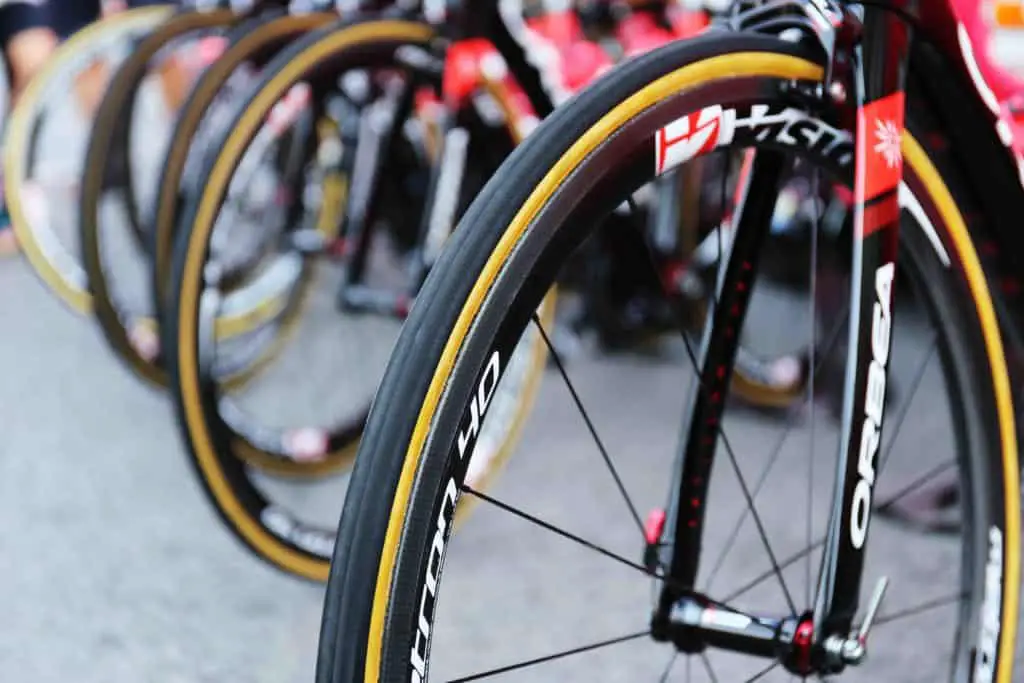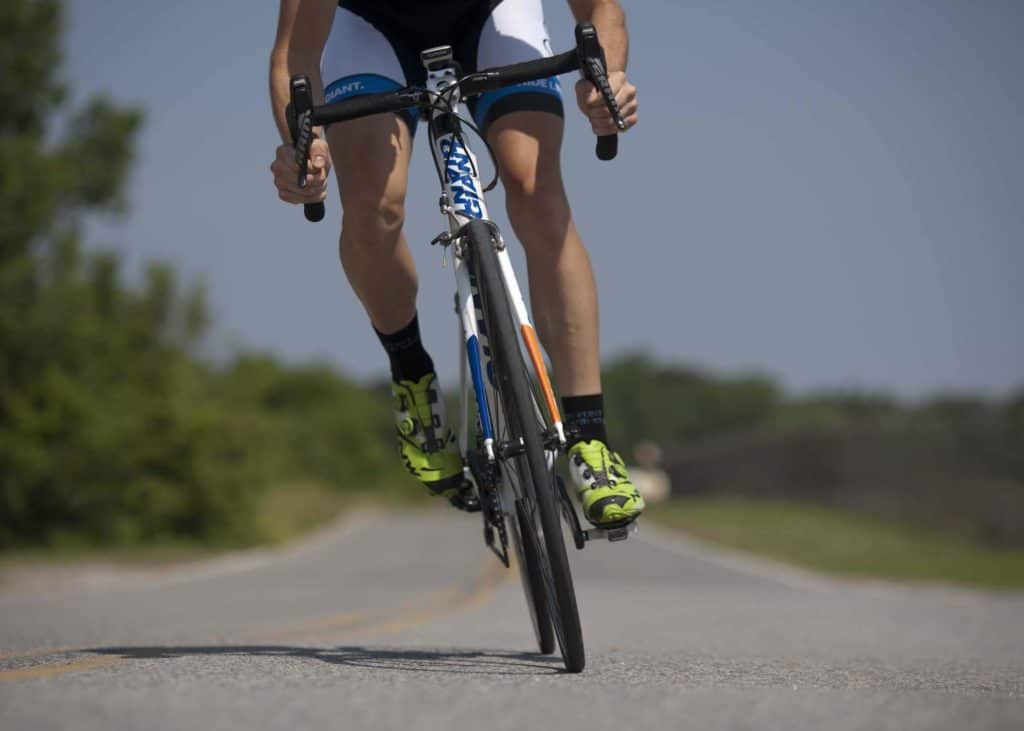
Most high-performance road bikes come with skinny 23mm tires. Those used in pro racing have even narrower tires, as skinny as 18mm, even though fat tires are touted as both comfy and stable. So why do road bikes have narrow tires?
Join us for a detailed look at all these questions and more.
Key Takeaways:
- Designed for Smooth Roads: Road bikes are made for smooth and paved urban roads, where narrow tires perform better.
- Speed Optimization: Narrow tires help road bikes achieve higher speeds by minimizing wind resistance, rolling resistance, and improving aerodynamics.
- Wind Resistance: Narrow tires cut through wind resistance more efficiently than wider ones, contributing to improved speed.
- Rolling Resistance: Thinner tires generally have better rolling resistance, but recent arguments suggest that thicker tires may be faster due to tire deflection.
- Aerodynamic Advantage: Narrow tires with smaller frontal areas reduce drag, enhancing aerodynamic performance and making pedaling more efficient.
- Lightweight and Traction: Narrower tires are lighter, enhancing bike’s overall speed. Additionally, they cut through snow for better traction and speed on slippery surfaces.
- Improved Braking: Skinny tires often feature bigger rims, allowing for larger braking components and shorter braking distances.
What Are Road Bikes for?
Road bikes are made for driving on super-smooth, paved urban roads. The operative term here, of course, is smooth and paved. Many urban streets are littered with glass debris and loose gravel, which affect speed and are just two of the many culprits that puncture narrow tires.
So Why Are Road-Bike Tires Narrow?
Road bikes generally come with 23mm or 25mm tires as the default width. Racers go even skinnier with 21mm tires or narrower. Here are the most important reasons for that.
Speed, Speed, Speed
Road bikes were designed to zoom by on smooth asphalt, and, even though not all road bikes are racing bikes, many are the choice for pro racing. These two reasons made speed a key point.
Consequently, narrow tires were the solution for the three issues that affect speed: Wind resistance, rolling resistance, and aerodynamics.

Wind Resistance
The first culprit behind drag is wind resistance. Even though cyclists wear tight clothes and use drop bars to help them cut through it, wind resistance only increases the faster they go. Narrow tires slice through wind resistance easily and faster than wider tires.
Keep in mind that the difference in speed can be mere fractions of a second. While this may not matter much to regular folk, it’s a vital consideration for racing pros.
Rolling Resistance
Different tires roll with different smoothness levels. This happens because of rolling resistance, which is the energy necessary to flex the tire surface where it contacts the ground. It’s also the second reason for drag after wind resistance.
Here are some of the tire specifications that affect rolling resistance:
- Width
- Air pressure
- Sidewall
- Material
- Casing thickness
- Tread thickness
Until recently, scientists and engineers agreed that thinner tires had better rolling resistance. In the last few years, however, we’ve seen a new argument: At the same pressure, thicker tires are faster because of tire deflection, which is the way tires distribute weight under a load.
When your tire flattens under your weight, part of it touches the road as a flat contact surface. At equal air pressure, a fat tire and a skinny tire will have the same contact surface. A fat tire has a wide but short contact area, while a skinny tire has a thin yet longer contact area.
Because a narrow tire’s flattened contact area is longer, it deforms more and loses more of its round shape while rotating. By contrast, a fat tire’s flattened contact area is shorter. This helps it keep more of its round shape, so it rolls better and faster.
Aerodynamics
A narrow tire’s smaller frontal area reduces rolling resistance, which means lower drag. In turn, this gives you improved aerodynamics, so you exert less effort pedaling. Ideally, you’ll get the best aerodynamic performance when the tire’s diameter is 2-4mm less than the brake track width.
Lighter Weight
Narrower tires have less bulk than their wider counterparts. This makes them lighter and consequently faster. This is particularly noticeable with carbon-frame bikes, compared to the heavier aluminum frames of the past.
Better Snow Traction
Because fat tires maintain contact with a wider surface area, they generally provide better traction. However, surface contact isn’t the only source of traction: There’s also pressure per square inch. The greater it is, the better the traction, and that’s where skinny tires are superior.
This can be readily seen cycling on snow-covered roads. Narrow tires cut deeper through the snow, providing better traction and greater speed.
Improved Braking
Most skinny tires have bigger rims, which give cyclists a chance to install bigger braking parts. This can greatly reduce the braking distance, which is vital when you’re tearing through the streets and a congestion pops out of nowhere.
Disadvantages of Narrow Tires
Narrow tires come with two main drawbacks.
Less Grip
To avoid pinch flats, narrow tires must be pumped up to a high air pressure. This makes them super-stiff and reduces their contact area with the road, which severely limits their grip on the surface.
A fat tire, on the other hand, can run at lower pressures because it has a wider part touching the road. This means it can grip irregular parts of the road surface with more effectiveness. As a result, you have much more control when you take corners.
Less Comfort
Because narrow tires are pumped up until they’re extremely hard, they have almost zero shock absorption. Unless you’re gliding over silky smooth roads, you’re going to feel every single bump, pothole cover, and crack. You’ll also need to exert more effort to maintain stability.
A fat tire at a lower pressure has excellent shock absorption. This lets you enjoy a more comfortable ride and feel less tired afterward.
Can You Fit Fat Tires on Your Road Bike?
Before you buy a wider tire for your road bike, check the tire clearance your frame has. The space between the frame and fork and your tires will show you the biggest tire size you can get.
Wider tires will provide a more comfortable ride and probably a better sense of stability. It’ll come at the expense of the aerodynamics, but wide-tire enthusiasts don’t mind going slower and exerting more effort for comfort and stability.
As long as your bike frame has sufficient clearance for the fat tires you want, you can absolutely go ahead and experiment with wider tires.
Can Your Road Bike Go Super-Wide?
If 25mm and 28mm tires are fine, why stop there? Why not go all the way up to 45mm tires even?
There are a few obstacles to that. First, most road bikes come with frames that can’t even fit 28mm tires. It would be downright impossible to fit 35mm and 45mm ones.
Second, you can sacrifice aerodynamic performance to a certain degree with 25mm and 28mm tires, but any bigger will be simply incompatible with your wheel rims.
Finally, while it’s still possible to go fast on wider tires, they’ll increase your wheels’ rotational weight, which slows down your acceleration.
Can You Fit Cross Tires on Your Road Bike?
You can’t. Cross tires may fit your wheels, but you won’t be able to put the wheels back onto your frame. Cross tires are exclusively made for cross-bike frames.
Can You Ride a Road Bike on Unpaved Trails?

Since road bikes are specifically designed for smooth tarmac, they’re not your best bet for unpaved trails. You may feel they’re not as stable or comfortable. You could also be risking punctures with every roll of your wheels.
Most dirt-trail enthusiasts need to pack provisions, but road bikes aren’t suitable for heavy loads either due to their lighter weight. You’re better off with a mountain bike for that tough off-road terrain.
Can You Race on a Road Bike?

You absolutely can; in fact, road bikes are often used for racing by professional racing cyclists. The trick here is to know the right tire width.
While bicycle tires come in a vast array of widths, race bikes usually have the skinniest tires. This reduces weight and makes for better aerodynamics. The default width used to be 23mm or less, sometimes as narrow as 19mm. Lately, 25mm has slowly become the default tire width. Some newer race bikes can even take tires as wide as 28mm.
Puncture-Resistant Solutions for Narrow Tires
There are several ways to puncture-proof your road bike’s narrow tires. Tubeless tires are the best-known solution, but we’re leaving them out of our list because of their problematic drawbacks.
Keep in mind that regardless of the method you choose, you should always know how to fix a flat tire and have the necessary tools with you at all times.
Here are five ways to protect your narrow tires from punctures:
- Swap your tires for a pair of heavy-duty tires.
- If your rim bed has sharp edges sticking out, cover it with dedicated heavy-duty rim tape.
- Put latex sealant in your tubes, even if they’re not tubeless.
- Turn your old tires into lining for your new ones.
- If you have a rim-brake frame, attach a flint catcher to it.
Traction Solutions for Narrow Tires
Outfitting your road bike’s narrow tires with studs is an effective way of getting better traction on snow and slush.
FAQ: Thin Tire Bikes
Why do road bikes have narrow tires?
Road bikes have narrow tires because they offer several advantages compared to thick tires. Thin tires provide less rolling resistance, allowing the rider to go faster with less effort. They also require less energy to maintain a high speed on flat, smooth pavement. Additionally, thin tires have less contact with the ground, making road bikes ideal for smooth surfaces.
What is the difference between thin and thick tire sizes?
The main difference between thin and thick tire sizes is the width of the tire. Thin tires typically measure around 23-28mm in width, while thick tires, such as those used on mountain bikes, can measure 2-3 inches wide. The narrower the tire, the lower the rolling resistance and the faster the bike can go on smooth roads. Thick tires, on the other hand, provide better traction and are more suitable for rougher terrains.
Why do road bikes use thin tires instead of thick tires?
Road bikes use thin tires because they are designed for riding on smooth, paved surfaces. Thin tires offer less rolling resistance, allowing the cyclist to go faster with less effort. They also provide less contact with the road, which reduces friction and increases speed. Thick tires, while suitable for off-road and mountain biking, would create more drag and reduce the bike’s efficiency on paved roads.
Do thin tires have less air pressure than thick tires?
Yes, thin tires have less air pressure than thick tires. This is because thin tires don’t require as much air volume to provide optimal performance. The recommended tire pressure for thin road bike tires is typically around 80-120 psi (pounds per square inch) whereas thick tires, such as those used on mountain bikes, may require pressures of 30-50 psi.
What are the pros and cons of using thin tires on a road bike?
The pros of using thin tires on a road bike include faster speeds, less rolling resistance, and improved handling and braking. Thin tires also tend to be lighter than other types of tires, resulting in a lighter overall bike weight. However, thin tires are more susceptible to punctures and are less suitable for rough terrain compared to thick tires used on mountain bikes.
Can road bikes use thick tires?
Although road bikes are designed for thin tires, some models can accommodate slightly wider tires. These wider tires, often referred to as “tire bikes” or “skinny tires,” provide additional comfort and stability, especially on rougher road surfaces. However, road bikes with thick tires will have increased rolling resistance and may not be as efficient on smooth pavement.
Why don’t road bikes have thick tires like mountain bikes?
Road bikes don’t have thick tires like mountain bikes because they are optimized for riding on smooth, paved surfaces. Thick tires, while offering better traction on rough terrains, would create more rolling resistance on smooth roads, making it harder to go faster. Road bikes prioritize speed and efficiency, so thin tires are the preferred choice.
What are the benefits of using high-pressure tires on a road bike?
High-pressure tires offer several benefits for road bikes. By using high-pressure, road bikes can roll more easily and have less rolling resistance, allowing for faster speeds. The high tire pressure also provides better handling and braking performance, as the tires maintain their shape and grip on the road. The downside is that high-pressure tires are more susceptible to punctures and can feel less comfortable on rougher road surfaces.
Do road bikes with thin tires offer a smoother ride?
Road bikes with thin tires do not necessarily offer a smoother ride. The smoothness of the ride depends on various factors, including tire quality, tire pressure, road conditions, and the rider’s technique. While thin tires can absorb some vibrations due to their lower volume of air, a road bike’s rigid frame and high tire pressure can still transmit road imperfections to the rider. Ultimately, a smooth ride is achieved by choosing the right tire pressure, using quality tires, and having proper bike fit and technique.
Can road bikes with thin tires handle disc brakes?
Yes, road bikes with thin tires can handle disc brakes. In fact, many modern road bikes are equipped with disc brakes, offering better and more consistent braking performance compared to traditional rim brakes. The type of brake system is independent of the tire’s width, meaning road bikes can have thin tires and still benefit from the advantages of disc brakes.
Are road bikes with thin tires suitable for riding on all types of road surfaces?
Road bikes with thin tires are optimized for riding on smooth, paved surfaces, such as roads, bike paths, and tracks. While they can handle some slightly rougher surfaces, such as hard-packed dirt or gravel roads, road bikes are not designed for off-road trails or extremely bumpy terrains. For those types of surfaces, mountain bikes with thicker and more robust tires are more suitable.
The Bottom Line
Narrow tires give road bikes better wind resistance and aerodynamics, lighter weight, and better traction on the snow. You also have narrow tires to thank for your improved braking performance. As for puncture risks, there are various ways to puncture-proof your skinny tires.
Ultimately, the terrain you travel most of the time should be the biggest factor in your choice. Merely living in a city doesn’t in and of itself mean a narrow tire is your best bet.
If your city streets are a glass-strewn nightmare of crumbling sidewalks, cracked asphalt, and potholes, a wider tire is the obvious choice. Just make sure to pick the size your bike has enough clearance for if you choose to outfit your road bike with wider tires. Happy urban trails!

